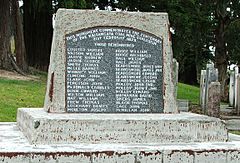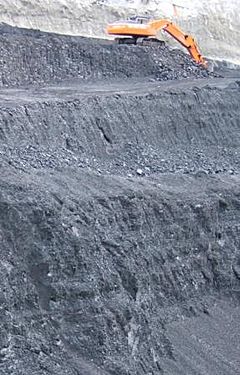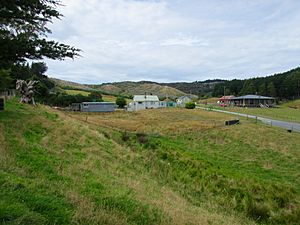Kaitangata, New Zealand facts for kids
Quick facts for kids
Kaitangata
|
|
|---|---|
| Country | New Zealand |
| Region | Otago |
| Territorial authority | Clutha District |
| Ward | Kaitangata-Matau |
| Electorates |
|
| Area | |
| • Total | 2.54 km2 (0.98 sq mi) |
| Population
(June 2023)
|
|
| • Total | 800 |
| • Density | 315/km2 (820/sq mi) |
| Postcode |
9210
|
| Area code | 03 |
| Local iwi | Ngāi Tahu |
Kaitangata is a town located near the coast in South Otago, New Zealand. It sits on the left bank of the Matau Branch of the Clutha River. The town is about ten kilometres southeast of Balclutha. Locals often call the town Kai.
In June 2016, Kaitangata became famous around the world. This happened when new, affordable homes were offered there. The mayor of Clutha District, Bryan Cadogan, said there were many job openings in the area. News about Kaitangata was shared by The Guardian and TVNZ's Seven Sharp.
Contents
Exploring Kaitangata's Location
The town of Kaitangata is very close to the coast. It is part of the Clutha River's delta, where the river splits into different branches before reaching the sea. Just southwest of the town is a small island called Inch Clutha.
North of Kaitangata, you can find a small lake named Lake Tuakitoto. This lake flows into the Clutha River through a small stream. This stream runs to the west of Kaitangata.
Kaitangata's Population and People
In 1863, only 29 people could vote in the wider Kaitangata area. This area included Inch Clutha and Matau. By 1865, the population for this larger area was 656 people. There were 403 males and 253 females.
The town grew a lot when the railway arrived. In July 1878, locals wanted Kaitangata to become a proper Municipality. Kaitangata was part of Bruce County at that time.
Statistics New Zealand describes Kaitangata as a rural settlement. It covers about 2.54 square kilometres. As of 2018, its population was 753 people. This means there were about 296 people per square kilometre.

The population of Kaitangata was 753 in the 2018 New Zealand census. This was a small decrease from 2013 and 2006. There were 324 homes in the town. There were more males (393) than females (363).
About 18.3% of the people were under 15 years old. Most people (90.8%) were European/Pākehā. About 17.1% were Māori. Some people identified with more than one ethnic group.
When asked about religion, most people (67.7%) said they had no religion. About 21.9% were Christian. A small number followed Māori religious beliefs or other religions.
Getting Around Kaitangata
At first, people traveled to Kaitangata by boat on the Clutha River. In 1862, there was a customs house, meaning it was a port where goods could enter the country.
Roads were difficult to use until the mid-1870s because they were poorly built and often flooded. A railway line, called the Kaitangata Line, was built in 1875. This line connected to the South Island Main Trunk. Its main purpose was to move coal. Before the railway, coal was shipped down the Clutha River.
Kaitangata's History and Name
Understanding the Town's Name
The meaning of Kaitangata's Māori name is not fully clear. It is the name of a figure in Māori stories. However, it might also refer to feasts held after tribal fighting. These fights were between the Kāi Tahu and the Kāti Māmoe iwi (tribes) in the area.
The name can be translated from Māori as "food" (kai) for "people" (tangata). Or it could mean "people for food." After a big mining accident in 1879, a local newspaper mentioned the name's meaning. It said the name was fitting given the sad event.
The “Te Aka Māori Dictionary” says that kaitangata can mean both a type of feast and a marine snail called the cat's eye snail (Turbo smaragdus).
Early European Settlers
In 1847, explorers like Joseph Thomas and Charles Henry Kettle surveyed the Otago Block. This land was between the Clutha and Tokomairaro Rivers. They marked the current spot of Kaitangata as a good place for a village.
European settlers started arriving in the early 1850s. They began sheep and dairy farming. John Lovell was the first settler in the town itself, arriving in 1855.
Coal was found nearby in 1844, but mining didn't start until the late 1850s. In Kaitangata, coal mining began in 1862. This was just after the first land sections were sold on February 28, 1862.
By 1862, Kaitangata had a customs house, a police station, and shops. The first Post Master was appointed in 1863. A primary school opened in 1866. By 1873, it had 50 students.
Flax mills opened in 1870. A saw mill was also set up before 1872. In 1873, a town library started. Cheese making also began. The town grew quickly in 1875–1876 when the railway arrived.
Community Groups and Activities
A cricket club was formed in January 1864. The Ancient Order of Oddfellows, a friendly society, was set up in September 1865. A Temperance Society started in 1871. By 1877, the town also had a football club.
Coal Mining in Kaitangata
Coal mining was the most important industry for Kaitangata from the 1870s until 1972. That's when the last underground coal mine, owned by the state, closed.
William Aitchinson started mining coal near Kaitangata in 1862. In 1871, he leased his mine to John Thompson. Thompson built a wooden tramway to move coal from the mine to the Matau River.
Underground Mining Operations
Besides Thompson's mine, MacFarlane and Martin opened a new mine in March 1872. This was called the No 1 Coal Company mine. In September, Thompson and Aitchenson created the Kaitangata Coal Mining Company. This company built a railway link to the South Island Main Trunk in 1875.
The underground mines produced high-quality sub-bituminous coal. This coal was mainly used to power steam locomotives in New Zealand until the 1960s. When trains switched to diesel, underground mining declined.
Worker Strikes
In 1873, miners at the Kaitangata Coal Mining Company went on strike. They wanted higher wages. Their demands were not met, and they returned to work after about a month.
Mining Accidents
In late 1873 or early 1874, the No 1 Company's mine caught fire. By July 1874, the fire had spread outside the mine, and efforts to put it out failed.
One of New Zealand's first major industrial disasters happened at the Kaitangata mine. On February 21, 1879, at 8 am, an underground explosion killed 34 miners. There were 47 men working at the mine that day.
It is believed that methane gas built up and was ignited. This happened when the mine manager's brother went into an unused part of the mine with a lit candle. The official investigation found that the mine manager and his brother were careless. It also noted that there were not enough laws about mine safety at the time.
Open-Cast Mining Today
Some open-cast mines (where coal is dug from the surface) have continued to operate. One example is the Kai Point Mine. The Kai Point Coal Company started mining coal in Kaitangata in 1951. It provides coal for local businesses and for heating homes.
The remaining open-cast mines produce lignite. This type of coal is mostly used in household fires and industrial boilers.
Kaitangata's Railway Line
In 1873, local people asked the government to build a railway line. They wanted a branch line from the South Island Main Trunk to Ropers Creek, near Kaitangata. This would make it easier to transport coal from the mines.
The Kaitangata Coal Company decided to build its own line. A railway construction company, the Kaitangata Railway Company, was formed. It then joined with the Coal Company, creating the Kaitangata Mining and Railway Company.
Construction of the railway line from Kaitangata to Stirling began in 1875. It was finished on March 31, 1876. This was a private line for the town and the mines. Later, the state Mines Department took over the line. It closed in 1970.
The train engine that worked on this line for many years was called an "Improved F". It was given to a preservation group at Shantytown in Westland. Today, it still runs heritage trains and is named "Kaitangata" to honor its past home.
Kaitangata's Environment
New Animals and Fish
In the 1860s, black swans and pheasants were brought to the area. Trout fish were also introduced into the Matau River in the 1870s.
Tsunami Event
On May 11, 1877, at 10 am, a large sea wave hit Kaitangata. This wave came from the 1877 Iquique earthquake. It caused the Clutha River to rise by 18 inches past Kaitangata. Eventually, the river rose four feet above its normal height. This happened every hour for most of that day.
Water Drainage and Flooding
In 1877, workers started to drain the lakes near Kaitangata. The community hoped this would stop the frequent flooding in the area.
However, at the end of September 1878, the entire town was severely flooded. No one died, but the town suffered a lot of damage. The road to Granton was washed away, and the railway bridge supports were damaged.
Recent Changes in Kaitangata
A local group, Kaitangata Promotions, has worked to improve the town's image. They have been involved in many community projects. In 2010, a museum about the coal mining industry opened in Kaitangata.
Affordable Homes in Kaitangata
In May 2016, Kaitangata Promotions started offering a special deal: a house and land package for $230,000. In June, this news spread across New Zealand. After a story in The Guardian, it became a worldwide sensation. For example, by the end of June, Kaitangata's Wikipedia page was viewed more often than pages for big cities like Sydney and Los Angeles.
The mayor of Clutha district, Bryan Cadogan, said that "more than 10,000 people" had shown interest in moving to Kaitangata.
Misinformation in the News
In early July 2016, some news outlets, like SFGate (part of the San Francisco Chronicle), wrongly reported that the Clutha District Council was giving away houses or money. This was not true.
Rules for Buying Homes
On July 5, property sales for the house and land package were temporarily stopped. The huge interest meant the promotions group wanted to make sure that real settlers were buying the land, not just people hoping to make a quick profit.
To do this, rules were set. Buyers had to state what they planned to do with the land. Speculators (people buying just to resell quickly) were not encouraged. Buyers also had to agree to build a house within two years.
Education in Kaitangata
Kaitangata School is a public primary school for students from Year 1 to 8. It teaches both boys and girls. The school was founded in 1866.
Famous People from Kaitangata
- Tony Brown, a rugby player who played for the All Blacks.
See also
 In Spanish: Kaitangata para niños
In Spanish: Kaitangata para niños




